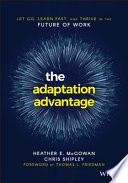

In today's fast-paced world, change is the only constant. The authors emphasize the importance of embracing change rather than resisting it. Organizations that can adapt quickly to shifting circumstances—whether they be technological advancements, market fluctuations, or societal shifts—tend to thrive. This idea underscores the necessity of cultivating a mindset that welcomes change. Leaders are encouraged to foster a culture where experimentation and innovation are celebrated, allowing teams to pivot and adjust strategies in response to new information or challenges. This proactive approach to change can lead to a more resilient organization that is better equipped to handle uncertainties.
Continue readingAgility is a critical attribute for both individuals and organizations in the modern landscape. The book discusses how agile organizations can respond to customer needs more effectively and can outpace competitors who are slower to adapt. The authors suggest that agility is not just about speed; it's also about flexibility and the ability to iterate quickly. This involves not only streamlining processes but also empowering employees to make decisions and take ownership of their work. By fostering an agile environment, organizations can enhance their responsiveness and creativity, leading to better outcomes and increased satisfaction among stakeholders.
Continue readingTechnology plays a pivotal role in facilitating adaptation. The authors highlight various technological tools and platforms that can help organizations collect data, analyze trends, and make informed decisions quickly. By leveraging technology, businesses can enhance their adaptability, whether through automation, data analytics, or digital communication tools. The book provides examples of companies that have successfully implemented technology to pivot their strategies or improve their operations. This idea encourages readers to view technology not just as a tool for efficiency but as a vital component in their adaptation strategy.
Continue readingA learning culture is essential for fostering adaptation. The authors argue that organizations must prioritize continuous learning and development to stay relevant. This involves creating an environment where employees are encouraged to learn from failures, share knowledge, and pursue professional growth. The book outlines strategies for building a learning culture, such as offering training programs, promoting mentorship, and encouraging cross-functional collaboration. By investing in their workforce's development, organizations can enhance their adaptability and innovation, ultimately leading to sustained success.
Continue readingLeadership is crucial in guiding organizations through periods of change. The authors emphasize that effective leaders must not only be visionaries but also adept at managing change. They should communicate clearly, inspire their teams, and create a sense of purpose during transitions. The book discusses various leadership styles that promote adaptability, such as transformational and servant leadership. By modeling adaptability and resilience, leaders can instill these qualities in their teams, fostering a collective ability to navigate challenges and seize opportunities.
Continue readingIn an interconnected world, collaboration and networking are vital for adaptation. The authors argue that organizations should seek partnerships and alliances that enhance their capabilities and broaden their perspectives. By collaborating with other organizations, businesses can share resources, knowledge, and insights, leading to innovative solutions and faster adaptation to market changes. The book provides examples of successful collaborations and emphasizes the importance of building relationships within and outside the organization to foster a culture of adaptability.
Continue readingResilience is presented as a core competency necessary for adaptation. The authors discuss how organizations and individuals can develop resilience by cultivating a positive mindset, embracing challenges, and learning from setbacks. The book outlines strategies for building resilience, such as promoting mental well-being, encouraging risk-taking, and fostering a supportive environment. By prioritizing resilience, organizations can better withstand disruptions and emerge stronger, ultimately enhancing their capacity for adaptation and growth.
Continue reading